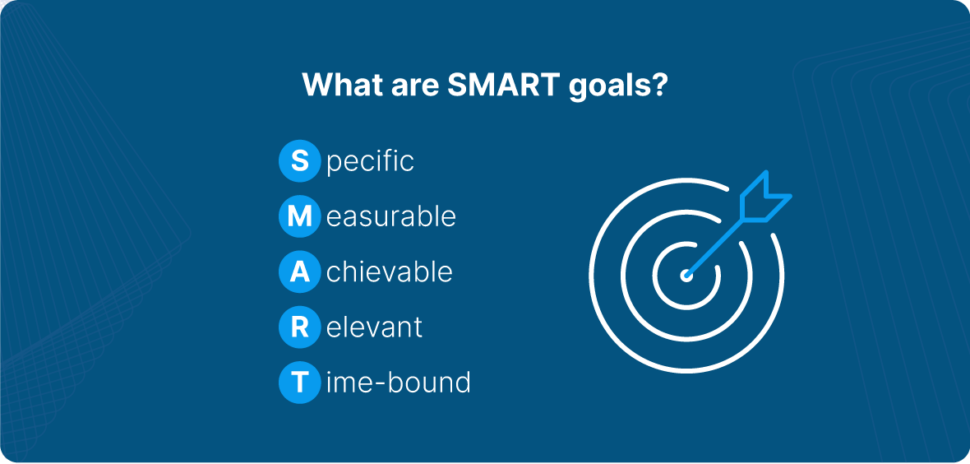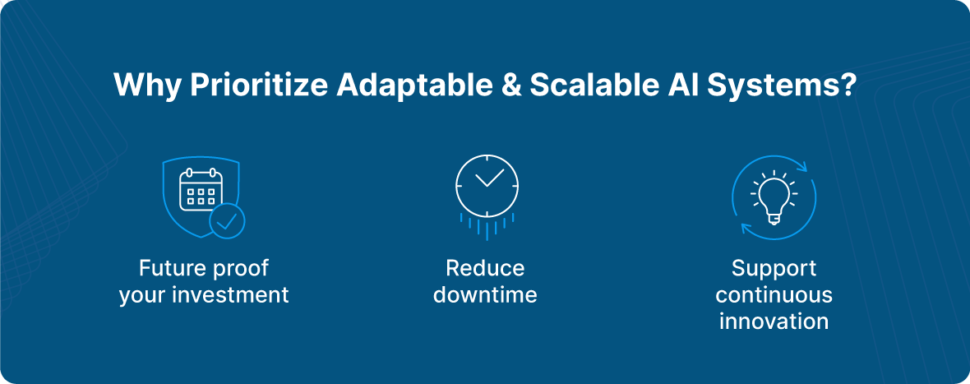Defining your business goals and objectives for artificial intelligence (AI) implementation is essential to develop an effective strategy that moves your organization forward. By outlining a clear vision of how AI aligns with broader strategies, you’ll ensure that integration drives progress instead of creating obstacles.
In this post, we’ll guide you through navigating AI implementation, highlighting the importance of defining business goals and objectives as the first step. Prioritizing alignment enables you to seamlessly incorporate AI technologies that align with your organizational goals, fostering intuitive integration and maximizing impact. Then, we’ll share how to monitor and optimize your efforts to guarantee long-term success.
Table of Contents
Why Align on Strategic Vision when Defining Business Goals + Objectives for AI Implementation
The best way to ensure a streamlined implementation is by first aligning your team on a strategic vision that inserts AI, business goals, and objectives. Once created, this shared vision acts as your north star throughout the integration process, providing an invaluable reference point. By developing a comprehensive understanding of how AI advancements align with broader organizational strategies, your team maintains a unified focus on how to leverage AI efficiently.
Strategic vision and industry discernment involve pinpointing specific areas where AI can make a significant impact, taking into account industry-specific challenges and broader macroeconomic factors. It’s critical to measure your initiatives to understand the effectiveness of your initiatives. You can start here:
→ KPI: Accuracy of predictive analytics powered by AI in foreseeing market trends
→ KPI: Market share growth in regions where competitors have not implemented AI technologies
When done correctly, your team is equipped to leverage AI to its fullest potential, tailored to the unique characteristics of your industry. This strategic alignment ensures that AI initiatives enhance efficiency, improve decision-making, and drive innovation, giving your organization a competitive edge. The difference is that your organization transcends mere technological adoption and instead commits to embedding AI deeply into its operations.
Without AI, your business is making decisions based on the past rather than the future. If you don’t prioritize alignment, you risk your team viewing AI as just another challenge rather than fully realizing its transformative capabilities.
What About Stakeholders?
Alignment also creates space for your organization to consider its stakeholders — from investors to end-users. By adopting a stakeholder-centric approach when developing a strategic vision, you underscore the importance of collaboration across various organizational departments.
Prioritizing stakeholder engagement enables your team to develop AI objectives that are highly relevant and aligned with the diverse expectations and needs of all parties involved. This approach also fosters a sense of shared ownership.
By engaging and considering stakeholders at every level, your team enhances its chances of achieving broader support, acceptance, and ultimately, the successful execution of AI initiatives. This comprehensive engagement strategy ensures that AI integration is not only effective but also sustainable, driving long-term value for the organization.
To guarantee stakeholder buy-in and alignment, there are two KPIs you’ll benefit from measuring:
→ KPI: Net Promoter Score (NPS) improvement from AI-enhanced customer experiences
→ KPI: Cost savings through AI initiatives compared to predefined targets.
How to Identify Business Challenges + Set Goals in Preparation of AI Implementation
Your first step towards successful AI implementation is to identify business challenges and set goals. Here’s how.
Take inventory of internal challenges.
To kick start the process, the first step is to identify and understand the internal challenges affecting your team’s efficiency and operations. These challenges may manifest as repetitive tasks ripe for automation, unwieldy datasets hindering insights, or a lack of predictive analytics to anticipate market trends.
Fortunately, AI offers a solution, promising to streamline operations and allowing your team to regain valuable time and resources.
With the assistance of AI, organizations can automate mundane tasks, extract insights from complex datasets, and gain predictive capabilities to forecast market shifts accurately. However, before diving into AI implementation, it’s essential to conduct a comprehensive inventory of the challenges affecting your team and stakeholders. This understanding serves as the foundation upon which tailored solutions can be developed.
Consider external factors, such as the competitive landscape.
In addition to internal challenges, it’s imperative to consider external factors, particularly the competitive landscape, when identifying obstacles on the path to AI implementation. By closely examining competitors’ strategies and technological advancements, organizations gain invaluable insights into market dynamics and customer expectations. Analyzing market trends and regulatory landscapes further informs the alignment of AI strategies with evolving market needs, empowering organizations to stay ahead of the curve.
Taking a proactive approach enables businesses to anticipate competitive threats, seize emerging opportunities, and customize AI solutions to gain a sustainable competitive advantage. This holistic approach fosters a deeper understanding of the business ecosystem, facilitating informed decision-making and optimal resource allocation to maximize the impact of AI initiatives.
Create SMART goals.
After thoroughly assessing internal challenges and external factors, the next step is to develop SMART goals—Specific, Measurable, Achievable, Relevant, and Time-bound—that guide the AI implementation journey. These goals offer direction and benchmarks to measure the efficiency of AI initiatives.
For example, a SMART goal could be to increase the average lifetime value (LTV) of customers impacted by AI-driven initiatives versus non-impacted customers by a certain percentage within a specified timeframe. By aligning these SMART goals with insights gleaned from internal assessments and external analyses, organizations can drive focused efforts towards optimizing outcomes and ensuring the success of AI implementation initiatives.
After you’ve successfully identified business challenges and objectives, there are several KPIs you should keep track of as AI implementation gets underway to gain insight into your program’s success:
→ KPI: Percentage reduction in operational costs through AI-driven automation
→ KPI: Average lifetime value (LTV) of customers impacted by AI-driven initiatives compared to non-impacted customers
The Importance of Prioritizing Adaptable + Scalable AI Systems
After your team has identified business goals and challenges in preparation for AI implementation, the next crucial step is to prioritize adaptable AI systems that scale in tandem with business growth. Here’s why.
- Future-proof your investment: As business needs inevitably evolve over time, selecting adaptable, scalable solutions safeguards your company’s investment in AI technologies. Prioritizing adaptability ensures that your organization won’t require extensive system overhauls as it expands.
- Reduce downtime: Scalable AI systems result in reduced downtime, which is an attractive buy-in for stakeholders. This approach mitigates bottlenecks and maintains operational efficiency, the overarching goal of AI implementation.
- Support continuous innovation: Your organization ensures that its technology infrastructure remains agile and primed for evolution, supporting continuous innovation. This forward-looking strategy drives strategic growth, ensuring that AI initiatives deliver substantial long-term value.
The KPIs your team should track to ensure you are properly prioritizing adaptable, scalable AI systems include:
→ KPI: Downtime reduction achieved through scalable AI systems
→ KPI: Revenue impact from accelerated time to market with agile AI development and scalable deployment
Additional Considerations
It’s also crucial your business considers its risk mitigation and contingency plans in regards to AI. By thinking about data security, biases, and system failures, your team ensures that it can swiftly respond to any misfirings. Therefore, your organization develops and showcases a proactive approach to risk management to mitigate potential harm. This foresight is also attractive to key stakeholders.
To measure and prove the effectiveness of your risk mitigation and contingency plans, focus on the following KPIs:
→ KPI: Average time taken to detect and respond to critical incidents within AI-driven systems
→ KPI: Total fines and penalties avoided due to proactive risk mitigation measures leveraging AI insights
Ensure Success with Monitoring + Optimization
Ensuring success with AI implementation requires continuous monitoring and optimization. By consistently assessing the performance of AI systems against predefined goals, businesses can quickly identify areas needing improvement and make fixes in real time. This iterative process not only facilitates the fine-tuning of AI algorithms but also ensures that the organization remains on course toward achieving its overarching objectives.
If your team is implementing AI correctly, the work is never truly finished. Vigilant monitoring allows organizations to proactively address emerging issues, optimize system efficiency, and adapt quickly to changes. By evaluating performance regularly, your team can enhance AI systems continuously, maintaining alignment with strategic goals as both the organization and technology evolve. This ongoing process ensures that AI initiatives drive maximum value and stay relevant in a dynamic business environment.
Here are the KPIs your team should track in regards to monitoring and optimization:
→ KPI: Accuracy of predictive models in forecasting outcomes
→ KPI: Operational cost savings from the optimization of resource utilization within AI infrastructure
Grow with Striim
Striim plays a critical role in AI implementation by offering real-time data integration and streaming analytics, which are essential for setting and achieving business goals and objectives. By enabling the continuous flow of data from various sources into AI systems, Striim ensures that your AI algorithms have access to the most up-to-date, comprehensive, and relevant information. Get started today with a free trial and learn more about how Striim can make your data work better for you.























